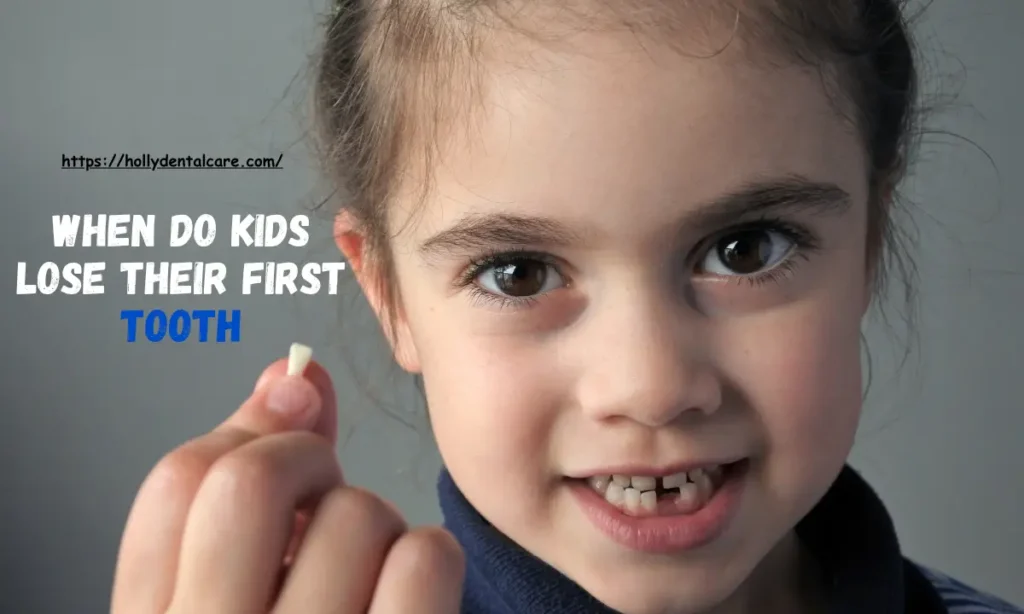Every single child goes through this journey in life like losing the first tooth, and this really is a unique step for that child and the parent as well. Although this age of shedding varies, the most common ages for children to start shedding their first teeth are approximately between 6 and 7 years and in kindergarten or in the first grades. Then, lose one by one those temporary ones, first one tooth and later the second. Such a procedure usually extends from the age of 5 or 6 and continues to the age of 12 when the first set is completed with the last one tooth from the first set.
When Do Kids Lose Their First Tooth
Usually, the first tooth is lost between the ages of 6 and 7. Generally beginning with the two lower central incisors. Tooth loss occurs in the same order in which teeth erupted and lasts until the age of about twelve, when all the temporary teeth have been replaced. However, any child may deviate from this schedule because his or her genetic and health factors differ. Signs of a tooth being on the way out include looseness and some mild discomfort. The parent should simply allow it to come out, maintain good oral hygiene, and make the experience pleasant. If it falls too early (before age four) or rather late (after age eight), it needs a dentist’s attention.
The “Milk Teeth” Lifecycle
Humans develop two sets of teeth:
- There are 20 primary (baby/milk) teeth that usually erupt between 6 months and around 33 months.
- Permanent (adult) teeth consist of 32 teeth with wisdom teeth, which come from the age of 6 to early adulthood.
Baby teeth are reportedly crucial for:
- Chewing and nutrition
- Speech development
- Guiding permanent teeth into place
- Maintaining jawbone structure and facial support
They’re designed to be temporary—soon to be replaced by their permanent successors!
Typical Age & Order of Tooth Loss
Age Range
- First tooth usually around 6–7 years
- Shedding of all baby teeth wraps up by about 12 years old
- There’s some flexibility—kids may start as early as 4–5 or later, around 7–8—yet that 6–7 window is where most fall .
Order of Loss
Loss tends to follow the order in which teeth erupted:
- Lower central incisors (bottom front)
- Upper central incisors (top front)
- Lateral incisors (next to central incisors)
- First molars
- Canines (cuspid, “sharp” teeth)
- Second molars
A general timeline table:
| Tooth Type | Typical Loss Age |
| Lower central incisors | 6–7 years |
| Upper central incisors | 6–7 years |
| Lateral incisors | 7–8 years |
| First molars | 9–11 years |
| Canines | 9–12 years |
| Second molars | 10–12 years |
Why Some Kids Lose Teeth Earlier or Later
It’s normal for timelines to shift based on:
- Genetics – early teething often leads to early shedding
- Tooth eruption schedule – if baby teeth arrived early, they may depart earlier too .
- Health and dental issues, such as:
- Teeth falling out too early: probably because of decay, trauma, and rarely because of genetic conditions such as Papillon-Lefèvre or hypophosphatasia.
- Late lost teeth: they may indicate some kind of syndromes or immunodeficiencies such as Andersen-Tawil or hyper IgE syndrome.
Signs Your Child’s Tooth Is About to Fall Out
- The tooth wobbles or is loose
- Gum around the tooth may be a bit tender
- Mild discomfort or a “funny” feeling while eating
- No major pain—usually falls out quickly and without fuss
What You Should (and Shouldn’t) Do
Do:
- Let it loosen naturally – gentle wiggling is usually all a child needs.
- Clean the gum area – first, rinse with lukewarm water, use a clean gauze for mild bleeding.
- Manage discomfort – here, over-the-counter children’s acetaminophen or ibuprofen works well.
- Maintain brushing – moreover, handle carefully around the gap, but keep dental hygiene strong.
- Celebrate – the Tooth Fairy, a small treat, or praise can make the loss feel special.
Avoid:
- Pulling on a tooth that isn’t loose, let natural resorption of the root do its job.
- Using straws post-extraction—they can disturb the healing clot.
- Panic over mild bleeding or weird sensations—it’s usually part of the normal process.
After the Tooth Falls Out
- Permanent tooth should follow soon, typically within a few weeks to a few months
- Keep up dental check-ups—twice yearly is recommended
- Continue good oral habits: brushing, flossing floss gently once more teeth touch each other .
- Watch for orthodontic needs—persistent gaps or misalignment might mean a future visit to an orthodontist.
When to Call the Dentist
- Tooth lost very early, especially before age 5, without clear cause.
- Permanent tooth doesn’t appear after loose baby tooth is gone.
- Teeth falling out late—like still waiting by age 8–9 .
- Pain, swelling or signs of infection after tooth loss or during the process.
What the Experts Say
- American Dental Association (ADA): average loss at 6–7 years, often starting with the lower central incisors.
- Cleveland Clinic pediatric dentist: first teeth out at 6, last by 12; early or late usually okay unless accompanied by health issues.
- Denver Youth Dentistry: early loss (< 4) may mean space maintainers; monitor alignment.
- Invisalign (Northborough, MA): softer to eliminate grout lines before the final adjustment.
Conclusion
Losing the first tooth is an important milestone for your child-a wonderful mix of nostalgia and excitement. It usually happens between the ages of 6 and 7. Most commonly the first tooth to go is the bottom front tooth, followed by the other teeth in a specific order. It usually ends by the age of twelve. The timing should vary slightly from child to child; however, if there are great differences, particularly among many teeth, a check-up is warranted. The best strategy would be to support hygiene and celebration. Let the accurate loose tooth fall off, keep the place clean, handle little discomfort, and keep the whole process feel special by encouragement and customs such as the Tooth Fairy.
Also read:- How to Fix a Cracked Tooth Naturally: Best Remedies & Tips



